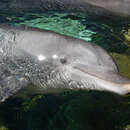en
names in breadcrumbs


Tursiops - Brief Summary
Everyone is familiar with the loveable dolphin known as Flipper, but most people are unaware that Tursiops truncatus, the common bottlenose dolphin, is only one of three bottlenosed dolphin species in the oceans today. The common bottlenosed dolphin is found in temperate and tropical waters worldwide, with sightings as as far north as Norway (Hammond et al., 2013) and far south as the Province of Chubut, in southern Argentina (Goodall et al., 2011). These friendly swimming mammals are found living offshore and inshore, whereas the other two species tend to occur closer to the coast.The smallest Tursiops is the Indian Ocean bottlenose dolphin (T. aduncus), which occurs along the continental shelf of the Indian Ocean from South Africa to Indonesia the waters fringing Southeast Asia, Australia, and Japan (Encyclopedia Britannica, 2013). The other is Burrunan Dolphin (T. australis), a medium-sized species with a tri-colored face, found off Australia’s southern and southeastern shores (Charlton-Robb et al., 2011). Typically, the inshore species are smaller in size and lighter in color than their offshore relatives (Encyclopedia Britannica, 2103). All three species are very social and are found traveling in large groups, or small pods ranging anywhere from two to fifteen dolphins (MarineBio, 2013).
Dolphins are very social and they like to travel and hunt for food in groups. One method of communal hunting is known as “fish whacking.” Some may think of it as them playing with their food; however, this is a very effective strategy. When the T. truncatus engage in “fish whacking” they strike a fish with their flukes and knock it out of the water. As the tasty treat is airborne, they plunge out of the water and catch it mid-flight (NOAA, 2013). Although this not the most strategic form of hunting, it may offer some amusement for these intelligent and social mammals.
As with many mammal species, the males are considerably larger than the females and the females tend to outlive the males. Their length ranges anywhere from 6-12 ½ feet long. The average life expectancy for these mammals is about 40 to 45 years for males, and more than 50 years old for females. Females reach sexual maturity between 5 and 13 years of age, and males mature between 9 and 14 (NOAA, 2013). Once they are of age to reproduce, females will carry the calf for a twelve-month period. Around eighteen months of age the female will wean the calf (MarineBio, 2013).